Balloons on a Mission
Special Stories
18 Feb 2018 7:17 PM
Weather balloon on your round trip quest
Data from the air is what you ingest
Filled up with helium and hydrogen too
Dragging your charge on a piece of sinew
Sail through the sky the top your intent
Your path is the mission on which you are sent
So sample the air as you climb by the meter
Metric system in use like centigrade and liter
With constant transmission you send by radio
All of your findings that we need to know
Somewhere on high you hear a loud pop
Just about then you just start a long drop
Back in the direction from that which you came
Gravity it seems has made a fair claim
Falling through the air without a heat shield
You may end up in some farmer’s wheat field
That is your journey and there it will end
Tomorrow another will do it again
-Mike Morrison
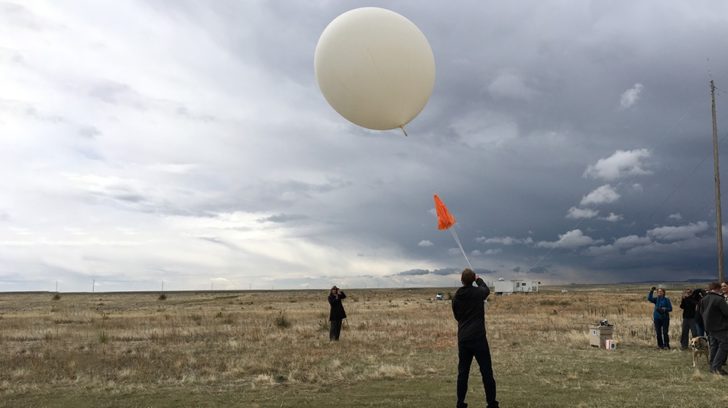 Every day, twice a day and more often if the weather dictates, large balloons lift instruments to measure the state of the atmosphere at the moment. These launches are conducted by the National Weather Service and other meteorological entities across the globe. The meteorological instrument parcel tethered to the “weather balloon” will measure various properties of the atmosphere and relay by radio transmission the results to receivers back on earth.
Every day, twice a day and more often if the weather dictates, large balloons lift instruments to measure the state of the atmosphere at the moment. These launches are conducted by the National Weather Service and other meteorological entities across the globe. The meteorological instrument parcel tethered to the “weather balloon” will measure various properties of the atmosphere and relay by radio transmission the results to receivers back on earth.
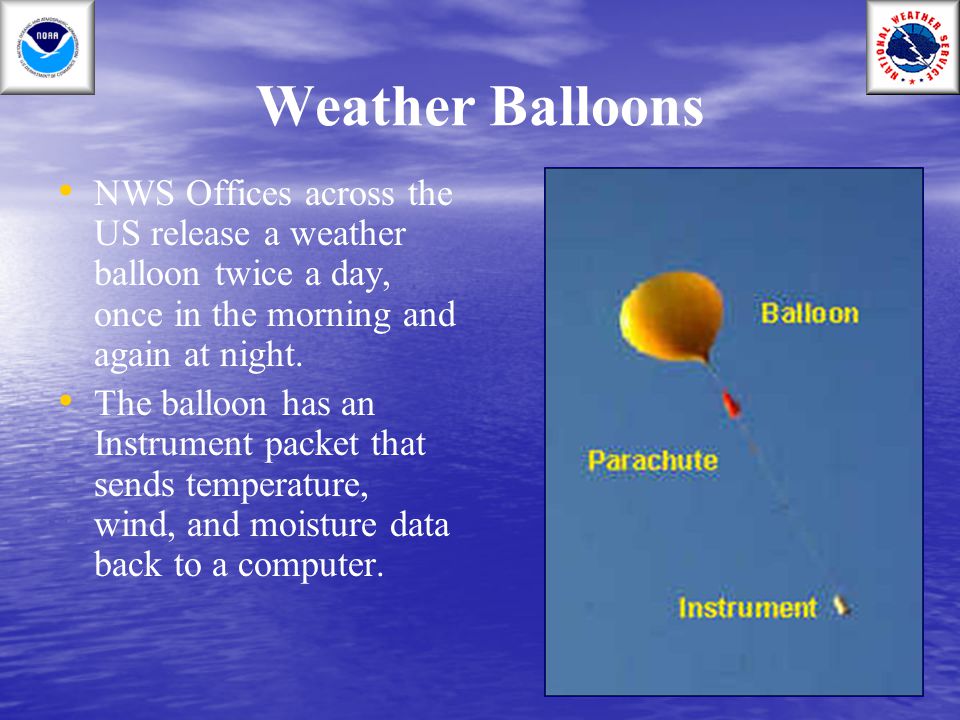 The balloon has an Instrument packet that sends temperature, wind, and moisture data back to a computer.
These launches are imperative for the science of weather and the data they collect give us a snapshot of the state of the atmosphere all over the world.
Radiosondes are routinely launched twice a day from about 92 stations across the US by the National Weather Service. Of the 92, stations, 69 are located in the conterminous United States, 13 in Alaska, 9 in the Pacific, and 1 in Puerto Rico. NWS also supports the operation of 10 other stations in the Caribbean. Worldwide, there are over 800 upper-air observation stations and through international agreements data are exchanged between countries.
These launches are coordinated and launched a short time before 00z and 12z daily. This nearly simultaneous release gives us a basic picture of the state of the atmosphere at a set time two times a day.
Most radiosondes measure or calculate the following variables:
Pressure
Altitude
Geographical position (Latitude/Longitude)
Temperature
Relative humidity
Wind (both wind speed and wind direction)
Cosmic ray readings at high altitude
The balloons used to carry the radiosondes are of course much larger than the “party balloons” we most often see. The balloons are made of rubber or latex and are filled with enough hydrogen or helium to lift the radiosonde high into the atmosphere. These balloons when released are filled with about 1500 grams of helium and start out about 5 feet in diameter. Of course as the balloon ascends the atmospheric pressure decreases with height and the balloon expands. These balloons expand to a fairly impressive size and when they get to about 20-25 feet in diameter they burst and the radiosonde falls back to earth. To help minimize the danger to people and property a parachute slow the descent of the instrument package as it falls. The flight vertically and horizontally can last in excess of two hours and reach heights of over 115,000 feet and can travel more than 180 miles from the launch location.
The balloon has an Instrument packet that sends temperature, wind, and moisture data back to a computer.
These launches are imperative for the science of weather and the data they collect give us a snapshot of the state of the atmosphere all over the world.
Radiosondes are routinely launched twice a day from about 92 stations across the US by the National Weather Service. Of the 92, stations, 69 are located in the conterminous United States, 13 in Alaska, 9 in the Pacific, and 1 in Puerto Rico. NWS also supports the operation of 10 other stations in the Caribbean. Worldwide, there are over 800 upper-air observation stations and through international agreements data are exchanged between countries.
These launches are coordinated and launched a short time before 00z and 12z daily. This nearly simultaneous release gives us a basic picture of the state of the atmosphere at a set time two times a day.
Most radiosondes measure or calculate the following variables:
Pressure
Altitude
Geographical position (Latitude/Longitude)
Temperature
Relative humidity
Wind (both wind speed and wind direction)
Cosmic ray readings at high altitude
The balloons used to carry the radiosondes are of course much larger than the “party balloons” we most often see. The balloons are made of rubber or latex and are filled with enough hydrogen or helium to lift the radiosonde high into the atmosphere. These balloons when released are filled with about 1500 grams of helium and start out about 5 feet in diameter. Of course as the balloon ascends the atmospheric pressure decreases with height and the balloon expands. These balloons expand to a fairly impressive size and when they get to about 20-25 feet in diameter they burst and the radiosonde falls back to earth. To help minimize the danger to people and property a parachute slow the descent of the instrument package as it falls. The flight vertically and horizontally can last in excess of two hours and reach heights of over 115,000 feet and can travel more than 180 miles from the launch location.
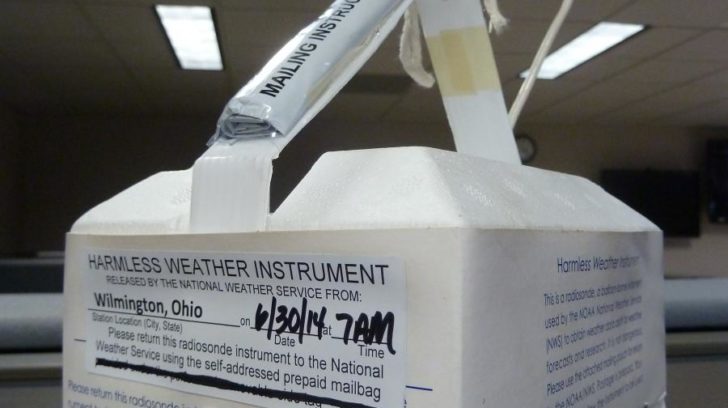 Along its flight the radiosonde sends back by radio data to a computer at the launch location to be stored and combined with data from other launches to ingest into forecast models we use daily. Wind speed and direction aloft are also obtained by tracking the position of the radiosonde in flight using GPS or a radio direction finding antenna. Observations where winds aloft are also obtained from radiosondes are called "rawinsonde" observations.
Data from these launches can be viewed in a graphical format on thermodynamic diagrams such as Skew-T log-P diagrams. http://weather.unisys.com/upper_air/skew/
Along its flight the radiosonde sends back by radio data to a computer at the launch location to be stored and combined with data from other launches to ingest into forecast models we use daily. Wind speed and direction aloft are also obtained by tracking the position of the radiosonde in flight using GPS or a radio direction finding antenna. Observations where winds aloft are also obtained from radiosondes are called "rawinsonde" observations.
Data from these launches can be viewed in a graphical format on thermodynamic diagrams such as Skew-T log-P diagrams. http://weather.unisys.com/upper_air/skew/
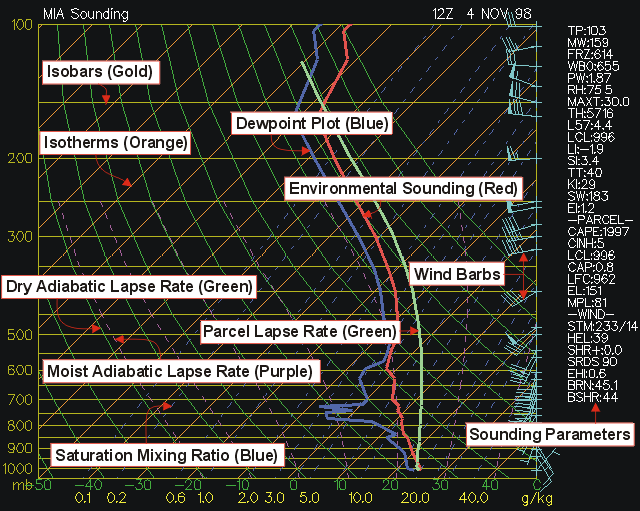 There are ground based instruments that have been invented that also can give us a vertical snapshot of important indices of the atmosphere. I’ve consulted with a company out of Colorado that produces such a product and markets it around the world. Radiometrics in Boulder Colorado makes several models of microwave profilers that deliver continuous temperature and humidity data with the accuracy of the balloon launched radiosonde. These ground based profilers may one day replace the need for launching radiosondes with balloons.
There are ground based instruments that have been invented that also can give us a vertical snapshot of important indices of the atmosphere. I’ve consulted with a company out of Colorado that produces such a product and markets it around the world. Radiometrics in Boulder Colorado makes several models of microwave profilers that deliver continuous temperature and humidity data with the accuracy of the balloon launched radiosonde. These ground based profilers may one day replace the need for launching radiosondes with balloons.
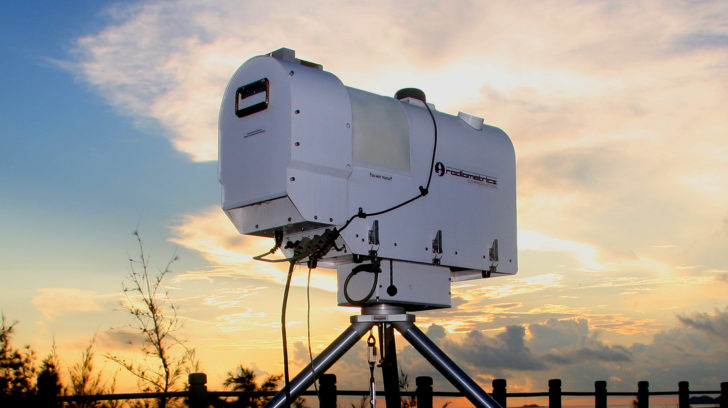 Over a course of a year the National Weather Service launches about 75,000 weather balloons and few radiosondes are actually recovered. If you do happen to find one, be careful of the battery as it can leak and can cause skin and eye damage and could ruin a coffee table fairly quickly. The radiosondes themselves contain packaging to mail the unit back to NOAA to be refurbished and used again.
Over a course of a year the National Weather Service launches about 75,000 weather balloons and few radiosondes are actually recovered. If you do happen to find one, be careful of the battery as it can leak and can cause skin and eye damage and could ruin a coffee table fairly quickly. The radiosondes themselves contain packaging to mail the unit back to NOAA to be refurbished and used again.
 Meteorologist Mike Morrison
Meteorologist Mike Morrison
 Every day, twice a day and more often if the weather dictates, large balloons lift instruments to measure the state of the atmosphere at the moment. These launches are conducted by the National Weather Service and other meteorological entities across the globe. The meteorological instrument parcel tethered to the “weather balloon” will measure various properties of the atmosphere and relay by radio transmission the results to receivers back on earth.
Every day, twice a day and more often if the weather dictates, large balloons lift instruments to measure the state of the atmosphere at the moment. These launches are conducted by the National Weather Service and other meteorological entities across the globe. The meteorological instrument parcel tethered to the “weather balloon” will measure various properties of the atmosphere and relay by radio transmission the results to receivers back on earth.
 The balloon has an Instrument packet that sends temperature, wind, and moisture data back to a computer.
These launches are imperative for the science of weather and the data they collect give us a snapshot of the state of the atmosphere all over the world.
Radiosondes are routinely launched twice a day from about 92 stations across the US by the National Weather Service. Of the 92, stations, 69 are located in the conterminous United States, 13 in Alaska, 9 in the Pacific, and 1 in Puerto Rico. NWS also supports the operation of 10 other stations in the Caribbean. Worldwide, there are over 800 upper-air observation stations and through international agreements data are exchanged between countries.
These launches are coordinated and launched a short time before 00z and 12z daily. This nearly simultaneous release gives us a basic picture of the state of the atmosphere at a set time two times a day.
Most radiosondes measure or calculate the following variables:
Pressure
Altitude
Geographical position (Latitude/Longitude)
Temperature
Relative humidity
Wind (both wind speed and wind direction)
Cosmic ray readings at high altitude
The balloons used to carry the radiosondes are of course much larger than the “party balloons” we most often see. The balloons are made of rubber or latex and are filled with enough hydrogen or helium to lift the radiosonde high into the atmosphere. These balloons when released are filled with about 1500 grams of helium and start out about 5 feet in diameter. Of course as the balloon ascends the atmospheric pressure decreases with height and the balloon expands. These balloons expand to a fairly impressive size and when they get to about 20-25 feet in diameter they burst and the radiosonde falls back to earth. To help minimize the danger to people and property a parachute slow the descent of the instrument package as it falls. The flight vertically and horizontally can last in excess of two hours and reach heights of over 115,000 feet and can travel more than 180 miles from the launch location.
The balloon has an Instrument packet that sends temperature, wind, and moisture data back to a computer.
These launches are imperative for the science of weather and the data they collect give us a snapshot of the state of the atmosphere all over the world.
Radiosondes are routinely launched twice a day from about 92 stations across the US by the National Weather Service. Of the 92, stations, 69 are located in the conterminous United States, 13 in Alaska, 9 in the Pacific, and 1 in Puerto Rico. NWS also supports the operation of 10 other stations in the Caribbean. Worldwide, there are over 800 upper-air observation stations and through international agreements data are exchanged between countries.
These launches are coordinated and launched a short time before 00z and 12z daily. This nearly simultaneous release gives us a basic picture of the state of the atmosphere at a set time two times a day.
Most radiosondes measure or calculate the following variables:
Pressure
Altitude
Geographical position (Latitude/Longitude)
Temperature
Relative humidity
Wind (both wind speed and wind direction)
Cosmic ray readings at high altitude
The balloons used to carry the radiosondes are of course much larger than the “party balloons” we most often see. The balloons are made of rubber or latex and are filled with enough hydrogen or helium to lift the radiosonde high into the atmosphere. These balloons when released are filled with about 1500 grams of helium and start out about 5 feet in diameter. Of course as the balloon ascends the atmospheric pressure decreases with height and the balloon expands. These balloons expand to a fairly impressive size and when they get to about 20-25 feet in diameter they burst and the radiosonde falls back to earth. To help minimize the danger to people and property a parachute slow the descent of the instrument package as it falls. The flight vertically and horizontally can last in excess of two hours and reach heights of over 115,000 feet and can travel more than 180 miles from the launch location.
 Along its flight the radiosonde sends back by radio data to a computer at the launch location to be stored and combined with data from other launches to ingest into forecast models we use daily. Wind speed and direction aloft are also obtained by tracking the position of the radiosonde in flight using GPS or a radio direction finding antenna. Observations where winds aloft are also obtained from radiosondes are called "rawinsonde" observations.
Data from these launches can be viewed in a graphical format on thermodynamic diagrams such as Skew-T log-P diagrams. http://weather.unisys.com/upper_air/skew/
Along its flight the radiosonde sends back by radio data to a computer at the launch location to be stored and combined with data from other launches to ingest into forecast models we use daily. Wind speed and direction aloft are also obtained by tracking the position of the radiosonde in flight using GPS or a radio direction finding antenna. Observations where winds aloft are also obtained from radiosondes are called "rawinsonde" observations.
Data from these launches can be viewed in a graphical format on thermodynamic diagrams such as Skew-T log-P diagrams. http://weather.unisys.com/upper_air/skew/
 There are ground based instruments that have been invented that also can give us a vertical snapshot of important indices of the atmosphere. I’ve consulted with a company out of Colorado that produces such a product and markets it around the world. Radiometrics in Boulder Colorado makes several models of microwave profilers that deliver continuous temperature and humidity data with the accuracy of the balloon launched radiosonde. These ground based profilers may one day replace the need for launching radiosondes with balloons.
There are ground based instruments that have been invented that also can give us a vertical snapshot of important indices of the atmosphere. I’ve consulted with a company out of Colorado that produces such a product and markets it around the world. Radiometrics in Boulder Colorado makes several models of microwave profilers that deliver continuous temperature and humidity data with the accuracy of the balloon launched radiosonde. These ground based profilers may one day replace the need for launching radiosondes with balloons.
 Over a course of a year the National Weather Service launches about 75,000 weather balloons and few radiosondes are actually recovered. If you do happen to find one, be careful of the battery as it can leak and can cause skin and eye damage and could ruin a coffee table fairly quickly. The radiosondes themselves contain packaging to mail the unit back to NOAA to be refurbished and used again.
Over a course of a year the National Weather Service launches about 75,000 weather balloons and few radiosondes are actually recovered. If you do happen to find one, be careful of the battery as it can leak and can cause skin and eye damage and could ruin a coffee table fairly quickly. The radiosondes themselves contain packaging to mail the unit back to NOAA to be refurbished and used again.
 Meteorologist Mike Morrison
Meteorologist Mike MorrisonAll Weather News
More